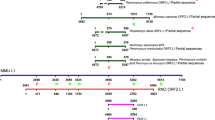Abstract
Two copies of nonmobile retrotransposon localized in D. melanogaster heterochromatin (mdg1 het) were sequenced at the 3′-end. The comparison of 2.5-kb mdg1 hetsequences with the sequence of cognate euchomatic transposable copies (mdg1 tr) revealed an intact mdg1 ORF2 encoding the pol gene in mdg1 het, and two-thirds of nucleotide substitutions in this ORF were synonymous. All the known mdg1 regulatory elements in the mdg1 hetLTR also are conserved, in spite of numerous deletions and nucleotide substitutions elsewhere in this region. These data suggest that the mdg1 hetsubfamily lost its mobility more recently than other functions were lost. The G→A hypermutation known to occur in the reverse transcription cycle of retroviruses was detected in one mdg1 hetcopy. The structure of the enchancerlike region in mdg1 hetsuggests a reduced transcription level and, therefore, transposition frequency, relative to mdg1 tr. The number of nucleotide substitutions suggests that the time of mdg1 hetmobility loss was less than 0.3–0.5 Myr ago.
Similar content being viewed by others
References
Arkhipova IR, Mazo AM, Cherkasova VA, Gorelova TV, Schuppe NG, Ilyin YV (1986) The steps of reverse transcription of Drosophila mobile dispersed genetic elements and U3-R-U5 structure of their LTRs. Cell 44:555–563
Arkhipova IR, Ilyin YV (1991) Properties of promoter regions of mdg1 Drosophila retrotransposon indicate that it belongs to a specific class of promoters. EMBO J 10:1169–1177
Avedisov SN, Cherkasova VA, Ilyin YV (1990) The primary structure features of the full-length copy of mdg1 Drosophila retrotransposon. Genetica (Russ) 26:1905–1914
Biessman H, Champion LE, O'Hair M, Ikenaga K, Kasravi B, Mason JM (1992) Frequent transpositions of Drosophila melanogaster HeT-A retrotransposons to receding chromosome ends. EMBO J 11:4459–4469
Britten RJ (1986) Rates of DNA sequence evolution differ between taxonomic groups. Science 231:1393–1398
Charlesworth B, Langley CH (1989) The population genetics of Drosophila transposable elements. Ann Rev Genet 23:251287
Cherkasova VA, Sedkov YA, Karavanov AA, Ilyin YV (1989) The localization of two nuclear protein binding regions in the body of Drosophila mobile element mdg1. Genetica (Russ) 25:2101–2110
Cherkasova VA, Avedisov SN, Ilyin YV (1990) An unusual organization of the leader and terminal regions of the Drosophila mobile element mdg1. Dokl Acad Nauk SSSR (Russ) 310:1485–1488
Danilevskaya ON, Petrov DA, Pavlova MN, Koga A, Kurenova EV, Hartl DL (1992) Repetitive DNA element, associated with telomeric sequences in D. melanogaster, contains open reading frames. Chromosoma 102:32–40
DiNocera PP, Graciani F, Giovanni L (1986) Genomic and structural organization of Drosophila melanogaster G elements. Nucleic Acids Res 14:675–691
Hagemann S, Miller WJ, Pinsker W (1990) P-related sequences in Drosophila bifasciata: a molecular clue to the understanding of the P element evolution in the genus Drosophila. J Mol Biol 31:478–484
Hu W-S, Temin H (1990) Genetic consequences of packaging two RNA genomes in one retroviral particle: pseudodiploidy and high rate of genetic recombination. Proc Natl Acad Sci USA 87:1556–1560
Inouye S, Yuki Sh, Saigo K (1986) Complete nucleotide sequence and genome organization of Drosophila transposable genetic element, 297. Eur J Biochem 154:417–425
Kimura M (1987) Molecular evolution clock and neutral theory. J Mol Evol 26:24–31
Kulguskin VV, Ilyin YU, Georgiev GP (1981) Mobile dispersed genetic element mdg1 of Drosophila melanogaster: nucleotide sequence of long terminal repeats. Nucleic Acids Res 9:3451–3464
Kuvakina AI, Nurminsky DI, Kogan GL, Gvozdev VA (1988) Developmental expression of Drosophila melanogaster transposable element mdg1. Genetica (Russ) 24:1234–1240
Lachaise D, Cariou M-L, David JR, Lemeunier F, Tsacas L, Ashburner M (1988) Historical biogeography of the Drosophila melanogaster species subgroup. Evol Biol 22:159–225
Lansmann RA, Shade RO, Grigliatti TA, Brock HW (1987) Evolution of P transposable elements: sequences of Drosophila nebulosa P element. Proc Nail Acad Sci USA 84:6491–6495
Lawrence JG, Hartl DL (1992) Inference of horizontal genetic transfer from molecular data: An approach using the bootstrap. Genetics 131:753–760
Li W-H, Gojobori T, Nei M (1981) Pseudogenes as a paradigm of neutral evolution. Nature 292:237–239
Maruyama K, Hartl DL (1991) Evidence for interspecific transfer of the transposable element mariner between Drosophila and Zaprionis. J Mol Evol 33:514–524
Mazo AM, Mizrokhi LJ, Karavanov AA, Sedkov YuA, Krichevskaja AA, Ilyin YuV (1989) Suppression in Drosophila:su(Hw) and su(f) gene products interact with a region of gypsy (mdg4) regulating its transcriptional activity. EMBO J 8:903–913
Miyata T, Yasunaga T (1981) Rapidly evolving mouse alphaglobin-related pseudo gene and its evolutionary history. Proc Natl Acad Sci USA 78:450–453
Mizrokhi LJ, Mazo AM (1991) Cloning and analysis of the mobile element gypsy from D. virilis. Nucleic Acids Res 19:913–916
Sambrook J, Fritsch EF, Maniatis T (1989) Molecular cloning. A laboratory manual. 2nd edition. Cold Spring Harbor Laboratory Press, Cold Spring Harbor, NY
Sharp PM, Li W-H (1989) On the rate of DNA sequence evolution in Drosophila. J Mol Evol 28:398–402
Shevelyov YY, Balakireva MD, Gvozdev VA (1989) Heterochromatic regions in different Drosophila melanogaster stocks contain similar arrangements of moderate repeats with inserted copia-like elements (MDG1). Chromosoma 98:117–122
Vartanian J-P, Meyerhans A, Asjo B, Wain-Hobson S (1991) Selection, recombination, and G→A hypermutation of human immunodeficiency virus type 1 genome. J Virol 65:1779–1788
Vaury C, Bucheton A, Pelisson A (1989) The beta-heterochromatic sequences flanking the I elements are themselves defective transposable elements. Chromosoma 98:215–224
Vaury C, Abad P, Pelisson A, Lenoir A, Bucheton A (1990) Molecular characteristics of the heterochromatic I elements from a reactive strain of Drosophila melanogaster. Chronicsoma 31:424–431
Vogt PK (1971) Genetically stable reassortment of markers during mixed infection with avian tumor viruses. Virology 46:947–952
Young MW (1979) Middle repetitive DNA: A fluid component of the Drosophila genome. Proc Natl Acad Sci USA 76:6274–6278
Author information
Authors and Affiliations
Rights and permissions
About this article
Cite this article
Nurminsky, D.I. Two subfamilies of MDG1 retrotransposon with different evolutionary histories in D. melanogaster . J Mol Evol 37, 496–503 (1993). https://doi.org/10.1007/BF00160430
Received:
Accepted:
Issue Date:
DOI: https://doi.org/10.1007/BF00160430




